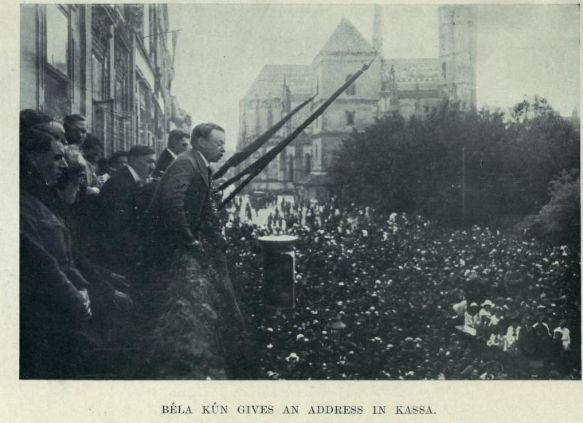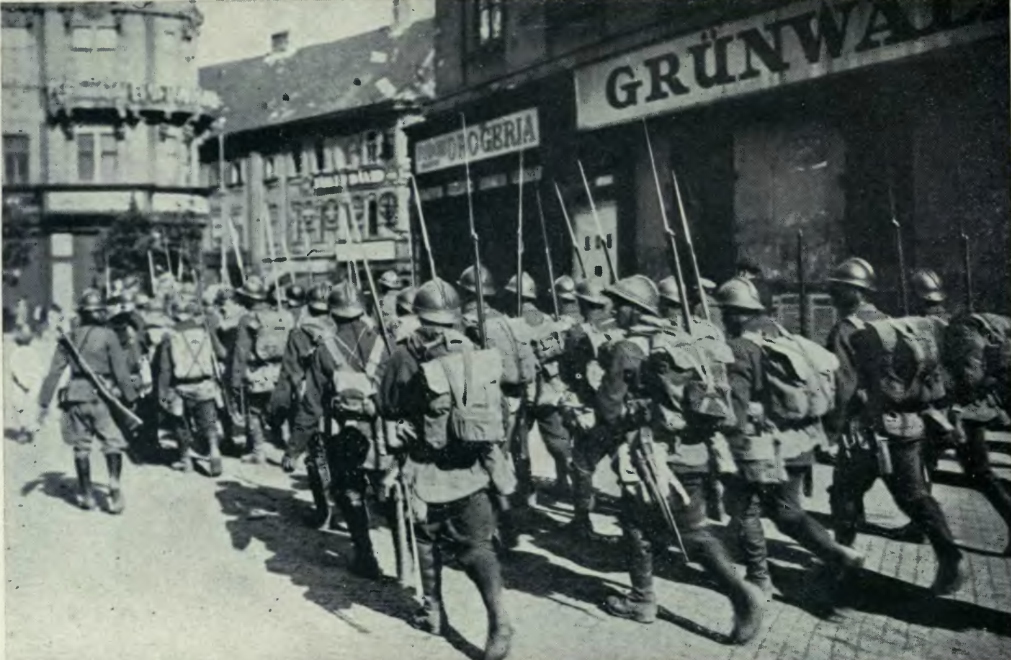The proclamation of the Republic of Councils in Hungary on March 21, 1919, and the enthusiasm it had shown towards Lenin’s new order worried the Allied Powers. In a Europe suffering after four years of devastating conflict, Bolshevism was regarded as a real threat for the old continent.
When negotiations broke down between the Allies and the government of Bela Kun, the Hungarian army violently attacked the Romanian troops in the Apuseni Mountains on the night of April 15-16 1919, an action almost immediately followed by the Romanian army’s counteroffensive. Facing the approximately 60.000 Hungarian soldiers, were six Romanian infantry divisions and three cavalry brigades, totalling about 64.000 soldiers. In just five days of operations, the Romanian army took control of the major centres Satu Mare- Carei- Oradea- Salonta. The frontline stretched north to the river Tisa, and in the south to the river Mureș.
Intelligence showed that after occupying the alignment that was agreed upon at the Paris Peace Conference, the enemy had concentrated its forces north of Debrecen. As a consequence, the General Headquarters intervened with the Allied Command of the Orient to approve the advance of Romanian troops to the Tisa river. When the Romanian troops reached this alignment by May 1, the Hungarian High Command had already planned a large-scale offensive over the Tisa with three assault groups and considered a possible junction with the Bolshevik troops in Ukraine.

Attack and counterattack
The offensive of the Hungarian army began on July 20, 1919, with a strong artillery preparation, followed by the main attack in the direction of Szolnok, in the centre, with another two secondary attacks in the flanks. Under the strong pressure of the enemy, the Romanian troops withdrew, with two Hungarian regiments succeeding in crossing the Tisa and establishing a bridgehead. The Great General Headquarters decided to begin the offensive at the same time by forcing the Tisa and breaking the enemy defence on the right bank of the river and advancing in the Szolnok- Budapest direction. Beginning with July 27, 1919, the first Romanian troops crossed the Tisa and established bridgeheads. The Romanian army engaged in offensive operations 119 battalions, 6 squadrons, 98 artillery batteries, with a total of about 120.000 men. Until August 2, 1919, the defence of the Hungarian forces was disorganized, so most of the Romanian divisions were to the west of the Tisa line. The Hungarian 1st Corps was taken out of combat, and its commanders had surrendered.
On August 3, Romanian troops successfully brought the offensive towards the capital of Hungary, so the first squadrons of the 3rd Roșiori Brigade, led by Colonel Gheorghe Rusescu, entered Budapest without a fight. The next day, the troops of the 1st Vânători Division entered Budapest, which on August 18 honoured the commander of the Romanian troops from Transylvania, general Gheorghe Mărdărescu, on the Andrassy Boulevard. In the parade there were also troops from the 4th Vânători Regiment, the 23rd Artillery Regiment and the 6th Roșiori Regiment. Colonel Rusescu’s initiative was not to the liking of General Mărdărescu. He took disciplinary action against the officer who dared to ruin the aura of his total victory.

Outstanding combat capabilities
The offensive proved that the Romanian army had managed to develop outstanding combat capabilities. Operational conception, logistics, and combined arms cooperation worked very well, aided by the excellent morale of the troops due to the general European context, to which were added the contributions of some Romanian officers from the former Austro-Hungarian army, who impressed with their professionalism and heroism. They will eventually occupy important functions in the interwar period and during the Second World War. The actions of the Romanian Army in 1919 supported the decisions taken by the Great National Assembly in Alba Iulia on December 1, 1918, and proved, if it was still necessary, the essential role of the army in building the Romanian unitary national state.


Romanians proclaimed war on Hungary,which was not a communist state that time. Check the chronology, and do not spread pseudo history.
In 1918, the Austro-Hungarian monarchy politically collapsed and disintegrated as a result of a defeat in the Italian Front (World War I). During the war Count Mihály Károlyi led a small but very active pacifist anti-war maverick fraction in the Hungarian parliament.[2] He even organized covert contacts with British and French diplomats in Switzerland during the war.[3] On 31 October 1918, the Aster Revolution in Budapest brought Hungarian liberal aristocrat Mihály Károlyi, a supporter of the Allied Powers, to power. The Hungarian Royal Honvéd army still had more than 1.400.000 soldiers[4][5] when Mihály Károlyi was announced as prime minister of Hungary. Károlyi yielded to U.S. President Woodrow Wilson’sdemand for pacifism by ordering the disarmament of the Hungarian army. This happened under the direction of Béla Linder, minister of war in the Károlyi government.[6][7] Due to the full disarmament of its army, Hungary remained without a national defence at a time of particular vulnerability.
International reactions after the Hungarian self-disarmament
After this, military and political events accelerated. On 5 November 1918, the Serbian army, with the help of the French army, crossed southern borders. On 8 November, the Czechoslovak Army crossed the northern borders, and on 13 November, the Romanian army crossed the eastern borders of the Kingdom of Hungary. On 13 November, Károlyi signed an armistice with the Allied nations in Belgrade. It limited the size of the Hungarian army to six infantry and two cavalry divisions.[8] Demarcation lines defining the territory to remain under Hungarian control were made.
The lines would apply until definitive borders could be established. Under the terms of the armistice, Serbian and French troops advanced from the south, taking control of the Banat and Croatia. Czechoslovakia took control of Upper Hungary and Carpathian Ruthenia. Romanian forces were permitted to advance to the Maros (Mureș) river. However, on 14 November, Serbia occupied Pécs.[9][10]
Interventions, fall of the liberal regime and communist coup d’état
Regional situation, 1914–1920
The Károlyi government failed to manage both domestic and military issues and lost popular support. On 20 March 1919, Béla Kun, who had been imprisoned in the Markó Street prison, was released.[11] On 21 March, he led a successful communist coup d’état. Károlyi was deposed and arrested.[12] Kun formed a social democratic, communist coalition government and proclaimed the Hungarian Soviet Republic. Days later the Communists purged the Social Democrats from the government.[13][14] The Hungarian Soviet Republic was a small communist rump state[15]. When the Republic of Councils in Hungary was established, it controlled only approximately 23 percent of the territory of Hungary’s classic territories.
The Communists remained bitterly unpopular[16] in the Hungarian countryside, where the authority of that government was often nonexistent.[17] The communist party and communist policies only had real popular support among the proletarian masses of large industrial centers – especially in Budapest – where the working class represented a high proportion of the inhabitants. The communist government followed the Soviet solution: the party established its terror groups (like the infamous Lenin boys) to “overcome the obstacles” in the Hungarian countryside. This was later known as the Red Terror in Hungary.
The new government promised equality and social justice. It proposed that Hungary be restructured as a federation. The proposal was designed to appeal to both domestic and foreign opinion. Domestic considerations included maintaining the territorial integrity and economic unity of former crown lands, and protecting the nation’s borders. The government had popular support and the support of the army. Most of the officers in the Hungarian army came from regions that had been forcibly occupied during World War I. This heightened their patriotic mood.[18] Hungary as a federation would appeal to President Wilson under his doctrine of self-determination of peoples due to the nation’s multi-ethnic composition. In addition, self-governed and self-directed institutions for the non-Magyar peoples of Hungary would lessen the dominance of the Magyar people.[18]
It isn`t like that. Between November 13th 1918 and March 1919 is just about Armistice on the Balkan Front. It is signed in Belgrade, Serbia, between the French General Franchet d’Esperey, chief of the Entente’s Oriental Army, and the Hungarian government. The agreement fixes demarcation lines between Hungary, Serbia and Romania, according to which the region of Banat goes under Serbian administration, in spite of the 1916 treaty with Bucharest. Körösvidék (Crișana) and Máramaros (Maramureș), including the cities of Szatmárnémeti (Satu Mare), Nagyvárad (Oradea), Belényes (Beiuș), and Arad, as well as the inner Transylvania up to the river Maros (Mureș), are left under Hungarian administration. Hungary is required by the Entente Powers to allow Romanian troops to enter the Transylvanian territories east of the demarcation line along Mureș. Hungary is allowed to keep only 8 army divisions. Disarmed troops are returning home.
After that was the negotiations in Arad between the Hungarian government of Károlyi Mihály and the Central National Romanian Council (of Transylvania), without reaching any agreement. News about the Belgrade agreement reach the Romanian (Transylvanian) delegation. The Central National Romanian Council retreats from negotiations and decides to hold elections and convey for November 18/December 1 the National Assembly of Romanians from Transylvania and Hungary, and to hand power to the latter.
Romanian troops occupy major mountain passes on the North-Eastern border of Hungary. They have the intent to occupy up about 1/4 of the territory of Transylvania, as allotted by the November 13 armistice in Belgrade to pass under its temporary administration. So, this was not actually war operations. It was only what the Armistice said.